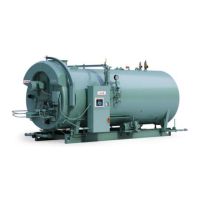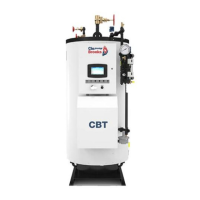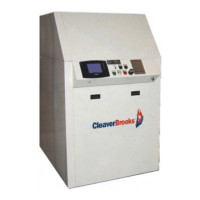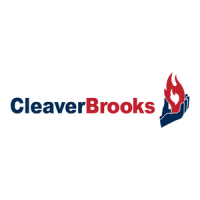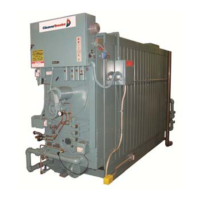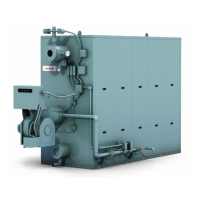750-392
CBEX-DE
2-5
Cleaning
2. Eliminate corrosive gases in the supply or boiler water.
3. Prevent inter-crystalline cracking or caustic embrittlement of boiler metal.
4. Prevent carryover and foaming.
Accomplishment of the above objectives generally requires proper feedwater treatment before and after introduc-
tion of the water into the boiler. The selection of pre-treatment processes depends upon the water source, its
chemical characteristics, amount of makeup water needed, plant operating practices, etc. Treating methods
include filtering, softening, de-mineralizing, deaerating, and preheating. After-treatment involves chemical treat-
ment of the boiler water. A water treatment expert should be consulted to determine an appropriate treatment
program.
Because of the variables involved, no single boiler compound can be considered a “cure-all” nor is it advisable to
experiment with homemade treating methods. Sound recommendations and their employment should be aug-
mented by a periodic analysis of the feedwater, boiler water, and condensate.
The internal or waterside surfaces of the pressure vessel should be inspected with enough frequency to determine
the presence of any contamination, accumulations of foreign matter, or corrosion, and/or pitting. If any of the con-
ditions are detected, contact your local Cleaver-Brooks authorized representative for advice on corrective action.
A properly sized water meter should be installed in the raw water make-up line in order to accurately determine
the amount of raw water admitted to the boiler (steam or hot water) and to aid in maintaining proper waterside
conditions.
2.4 — Cleaning
2.4.1 — Steam/Hot Water Piping
Steam piping systems connected to the boiler may contain oil, grease, or foreign matter. The impurities must be
removed in order to prevent damage to pressure vessel heating surfaces. On a steam system, the condensate
should be wasted until tests show the elimination of undesirable impurities. During the period that condensate is
wasted, attention must be given to the treatment of the raw water used as make-up so that an accumulation of
unwanted materials or corrosion does not occur. For more information, contact your local Cleaver- Brooks autho-
rized representative.
On a hot water system, chemical cleaning is generally necessary and the entire system should be drained after
treatment. A chemical treatment expert should be consulted regarding the best product for your application.
2.4.2 — Pressure Vessel
The waterside of the pressure vessel must be kept clean from grease, sludge, and foreign material. Such depos-
its, if present, will shorten the life of the pressure vessel, will interfere with efficient operation and functioning of
control and safety devices, and quite possibly cause unnecessary and expensive rework, repairs, and downtime.
The installation and operating conditions that the boiler will be subjected to should be considered and cleaning of
the waterside of the pressure vessel should be provided during the course of initial start-up.
The pressure vessel and the steam and return lines or hot water piping represent, in effect, a closed system.
Although the steam and return (condensate) lines or the hot water piping system may have been previously
cleaned, it is possible that:
1. Cleaning has been inadequate.
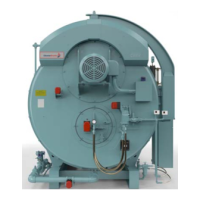
